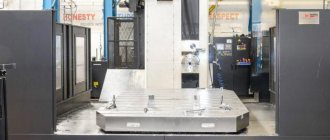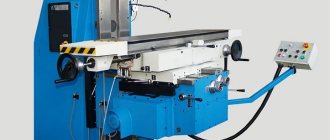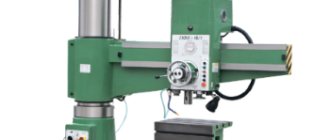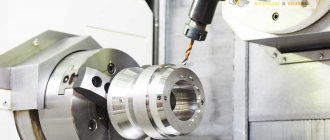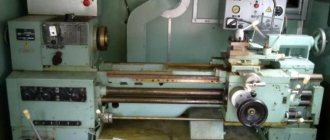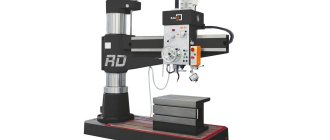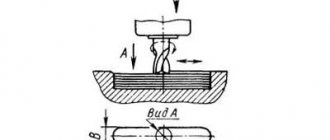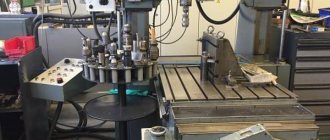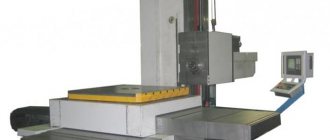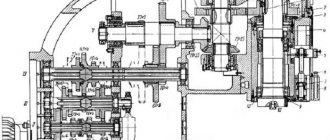News
Milling is a common method for processing parts made of different materials, and various variations of milling machines are used for this process. They are stationary devices for selecting grooves and splines, creating recesses on a shaped profile, drilling holes, countersinking and grinding. They are divided into 2 main groups, based on what material is processed. Thus, a metal cutting machine is used to make various iron shapes. Woodworking – for the manufacture of molded parts from wood and other types of work.
Features of the milling machine
The amount of electricity consumed, as well as performance indicators, depend on the power level of the unit. Household units have ratings of up to 1000 W, and professional ones – up to 7000. The length of the product for processing, in turn, depends on the dimensions of the working surface. The distance from it to the spindle determines the diameter of the workpieces that can be used. And the number of spindle revolutions is selected based on the equipment, the specified processing purpose and the level of hardness of the product. Most milling machines have a gearbox with several speed modes, which is more convenient to use.
What a milling machine can be like: SIGN SERVICE catalog
Such an installation can be of vertical or horizontal type, differing in the direction of the spindle axis. You can also purchase a universal model of the device - a combined milling machine. With it, products are processed in several planes at different angles, which is very convenient and practical to use. And widely universal models are distinguished by the presence of an additional head with a moving spindle.
In addition, this equipment can be of different sizes and areas of use. If you need a household unit, a tabletop model with low power is perfect. If this is industrial production, it is better to give preference to installations with higher engine power. They are industrial. Both variations are available on the website of the SINE SERVICE company, both in stock and on order.
Using milling machines
When performing operations on milling machines, the following equipment parameters are fundamental:
- Spindle position
. The spindle can move vertically, horizontally or at an angle to the product. - Number of spindle heads
. The design of the machine may include one, two or more spindle heads, as well as an additional removable head. - Desktop design
. Directly affects the movements of the table: whether it will move longitudinally or transversely, whether it will rise and fall, and also turn in different directions. - Number of axes
. There can be from 2 to 5 axes in machines. They determine the capabilities of a complex configuration of surface treatment of parts, as well as the performance of the unit. - Processing precision
. Operations can be performed with normal, high or increased precision. - Using various cutting tools
. On some units, only a small number of different cutters can be used, and certain machines allow the use of several dozen cutting tools. - Unit power
. Power directly affects the selection of workpieces with the appropriate level of hardness, determination of work speed and cutting depth. - Spindle speed
. Allows you to determine the types of materials allowed for work, as well as the quality of surface treatment. - Dimensions of the working area
. They determine the permissible dimensions of products accepted for processing.
Buying a milling machine for your home
Have you been wanting to buy a milling machine for your home for a long time, but don’t know which model to choose and what criteria to choose? We will be happy to help you choose equipment for any of your purposes! Household installations for cutting metal are similar to drilling equipment. This is a vertically located spindle on a bed and column; the work table of the device is equipped with flywheels for moving it. Due to this, it is possible to process workpieces in length, width, and depth. Metal, polyamide and other decorative parts can be selected as equipment.
Criteria for choosing a milling machine in the catalog
- Workpiece dimensions for processing. They must fit on the work surface, so the height from it to the shaft should be taken into account. If you use a rotating work surface or a vice, you need to add its height and the length of the workpiece to obtain the required value.
- Engine power level. The power characteristic must be taken into account without fail. Which machine to choose, where is the motor 150 W or 750 W? When the device will be used as actively as possible, and not once a month, then, of course, it is more advisable to choose a more powerful device, with which the work process goes faster. This is very important for industrial production. But machines with low engine power, such as 150 W, should be used sparingly. For plastic, polyamide products and non-ferrous metal workpieces, such models will be just right, but you should not choose them for working with steel.
- Installation and method of connecting equipment. When choosing a household-type milling machine, take into account the voltage indicators, since not all models have the function of connecting to a three-phase power supply. Therefore, it is optimal to purchase a device connected to a 220V network. As for placement, in a specially equipped workshop there are unlikely to be problems with the location of the installation. But this question arises for those craftsmen who work from home and do not have a separate, spacious room. The most profitable option here is a tabletop machine. It is smaller in size, lightweight and easy to move.
- Diameter of desired holes. In the technical specifications for each such device, the manufacturer indicates the maximum size of holes for drilling. For plastic blanks this value will be at least 2 times higher. It is especially important for those craftsmen who intend to use the equipment mainly for drilling. The maximum cutter diameter is equal to the width of the layer of material being processed at a time.
- Weight characteristics. As many people know, the greater the weight of such equipment, the higher the degree of its rigidity, and the high quality of work is ensured by the absence of vibrations during operation. Installations with dimensions of three hundred kg or more are often chosen for industrial purposes, since their functionality is too great for domestic use. Models weighing about 50 kg are well suited for home workshops. If you will be processing large-sized parts, then you can purchase a unit weighing over one hundred kg, the main thing is to worry about its further comfortable location.
Features of the milling group of machines
One of the classifications of metal-cutting machines is the type of processing. The milling process is significantly different from the operations performed on a lathe. Features of the group include the following:
- The main cutting tool is a milling cutter. It can be of various types, which affects the possibility of milling certain surfaces.
- Workpieces that have flat and shaped surfaces or are a body of revolution can be processed.
- The main distinguishing feature of the group is that the workpiece is fixed on the table and performs a reciprocating movement, and the cutter is fixed in the spindle and rotates.
The group under consideration has become widespread not only in mechanical engineering, like turning, but also in other areas of industry.
Classification
Considering the features of milling, there are quite a large number of varieties of metal milling machines. In this case, the classification is carried out according to various design features: the location of the spindle and table, their features, and so on.
Classification of machines
The first type is cantilever-milling. Representatives of this group differ from others in the presence of a console, which is the base for the table. A sled is attached to the console, along which the table moves during milling. The first type includes:
- Horizontal milling console machines with a fixed table - this group was the most common at the time of the existence of the USSR. Its features include simplicity of design, horizontal position of the spindle and the ability to mill one surface without rearranging the workpiece or changing the cutting tool.
- Horizontal milling console with rotary table or universal. Relocating a workpiece or changing tools takes quite a lot of time and also complicates the process from a technological point of view. That is why a rotary table was invented, which allows processing of several surfaces at once from one location.
- Vertical milling cantilever machines have also become widespread due to their simplicity of design. They are similar to drilling machines and many representatives of this group can carry out drilling, boring, and countersinking.
- Widely versatile milling machine. Representatives of this group are somewhat different from vertical milling versions. The main difference is the presence of an additional spindle head, which is located on the trunk. This retractable trunk is attached in such a way that it is possible to remove material at different angles in two selected planes. In this case, it is possible to use two spindles simultaneously or alternately. The highly versatile milling machine can be used for milling, drilling, boring and countersinking.
The next type is vertical milling with a cross table or non-cantilever. The name of the group indicates that the machines included in it do not have a console. The base can be a concrete slab or floor. Design features allow processing bulky, heavy workpieces.
Longitudinal milling machines are used for milling base and body workpieces. When using a certain cutting tool, it is possible to mill vertical, horizontal or inclined surfaces. The longitudinal type is widely used in areas where long workpieces are milled. This is due to the longitudinally located elongated table. The type of longitudinal milling machines is divided into the following classes:
- single-post;
- two-post;
Continuous milling machines differ from others in that the installation and relocation of the part is carried out without stopping the machine. Used in the production of large batches of parts. The group is divided into the following classes:
- Carousel milling machines are equipped with a table that resembles a carousel. Its special feature is the possibility of continuous roughing and finishing processing.
- Drum-milling machines allow you to process a part on both sides by roughing and finishing milling. They are used in mass production and the entire processing process is automated.
Copy milling machines are used to create grooves on parts. Purpose – milling profiles or reliefs. To automate the work, special templates are used that determine the shape of the surface of the part after metalworking.
Copy milling machine
Keyway milling machines are used to create keyways on workpieces of cylindrical and other shapes. Based on the principle of operation, they are divided into the following classes:
- Processing is carried out by vertical milling, the cutting depth corresponds to the required groove depth, taking into account finishing milling, after cutting, a longitudinal feed occurs along the length of the groove.
- The use of repeated reciprocating motion in a vertical position with constant movement of the cutter along the length of the groove.
- Using an eccentrically mounted cutter or using the oscillating cutting tool method.
Keyboard milling machine
Face milling machines are used for cutting ends and finishing them in large-scale production.
End milling machine
Specialized metal milling machines include all types of metalworking equipment that use a milling cutter as a cutting tool. Manufactured to create specific parts in large-scale production. These include thread milling, gear milling and other types of machines.
In addition, the group under consideration is also divided into options with Numerical Program Control (CNC) and with mechanical-electric drive.
Buy a milling machine on the SIGN SERVICE website
To buy a milling machine on the site, you no longer need to look for the best place for this, because it has already been found! You can purchase the necessary equipment at affordable prices and with delivery to the specified location. We have been working for many years, so we guarantee quality products and the best service. In addition to the fact that you can buy a milling machine on the website, we also offer to purchase all the necessary spare parts for repairs and consumables. Payment for goods is possible in installments or under a leasing program.
CNC milling machines: Main purpose.
Today it is impossible to imagine production without metalworking. Therefore, CNC metal-cutting machines are very popular. The leading positions among them are occupied by CNC milling machines. Based on the direction of spindle movement, they can be divided into two groups: vertical milling and horizontal milling.
CNC vertical milling machines are mainly used for drilling, boring and countersinking holes, forming grooves, etc. This is facilitated by 2 types of spindle movement: rotational and feed movement. The advantage of such machines is the ability to quickly replace tools to suit the required hole diameters and dimensions of the surfaces to be bored. It is also worth paying attention to the fact that the machines can process parts from almost all types of materials. Just keep in mind that when processing cast iron and other brittle metals, the heating of the cutting edge of the tool is not significant, and in the case of processing other materials, the mandatory use of coolant is required. The design of the spindle assembly of such machines makes it possible to process at high speed and achieve excellent product accuracy.
On milling machines, as a rule, two CNC systems are used - cyclic program control (CPU) and simple program control (CNC). Machines with a CPU are easier to use, since the program only performs the cyclic operation of the machine, and the remaining geometric settings are made using working elements (stops, couplings, etc.). CNC machines operate entirely from discrete data embedded in the program.
Before choosing which machine to purchase and which CNC system to install on it, a number of factors should be taken into account: in what type of production it will be used (serial, small-scale, mass); accuracy of the manufactured product; dimensions, complexity of installation and adjustment of the machine.
To ensure trouble-free operation of the machine, the following conditions must be observed:
Guarding the rotating and moving parts of the machine
Protection of the worker from the escape of coolant and chips.
Consider ventilation and lighting needs
Provide machine grounding
The leaders in the production and sale of CNC milling machines in the post-Soviet space are the Ryazan Machine Tool Plant, Bogorodsk Machine-Building Plant, St. Petersburg, etc. Good equipment is imported from Germany and Bulgaria.
- Shares
